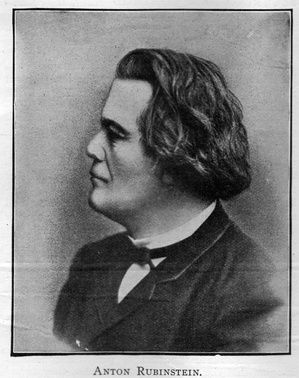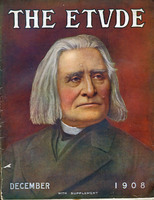|
|
BY ELLEN VON TIDEBOHL
|
[Editor's Note.—The following was selected from notes left by Mrs. E. N. Vessel, and translated expressly for The Etude. Mrs. Vessel attended the piano classes of Rubinstein in 1889-1890 and made a careful record of all the remarks of the great Russian pianist and teacher in her diary. These give a remarkable insight into the musical and pedagogical theories of the great pianist.]
Rubinstein was very animated while giving lessons. He spoke in figurative and symbolic language to make his ideas and advice clearer to the comprehension of his pupils. The three principal things he demanded of them were: (I) The choice of correct rhythm and time, (2) playing right notes and all the notes, (3) and careful shading, phrasing and right expression.
"I really cannot understand what kind of teacher it was who could not teach a pupil to count while playing," he once exclaimed while disgusted at the playing of a lady who, on account of great nervousness, did not play in time.
"Oh! I know where I would send such a teacher!" And then he spoke emphatically about the necessity of a musician getting a clear idea of the rhythm and tempo before setting himself to study a work.
"That is the first thing to do," he concluded, "and then try to play the notes and all of them clearly—we must wash the body before dressing it up finely."
"Play in the beginning slowly, firmly, until the new piece has entered into your fingers, after that only must you dare to use the pedaland give expression and phrasing to the melody."
VALUABLE HINTS.
 During his classes exclamations such as these would he heard: "Play clearly!" "Play all notes!' "I want to hear the chord perfect!" "Oh! the base-notes—they must all be sounded!" "Where is the principal note?" and so on.
During his classes exclamations such as these would he heard: "Play clearly!" "Play all notes!' "I want to hear the chord perfect!" "Oh! the base-notes—they must all be sounded!" "Where is the principal note?" and so on.
Now let us pass to the remarks concerning phrasing and expression. His own words were: "It is necessary to pay attention to all the signs marked by the composer. Don't play by heart before knowing the piece fundamentally, so that not one of the signs may be neglected. You ought to enter deeply into the work, try to guess at the deepest feelings of the composer."
Rubinstein had his own way of explaining pp, p, f, ff. You make no difference between piano and pianissimo," he told to one pupil, "the pianissimo sound must be like a sigh, but much deeper. Piano on the contrary varies according to requirement, being sometimes lyrical in character, and at others dreamy or expressing suffering, etc.
"Mezzo forte" was a soft sound in his comprehension, and "sforzando" had only the signification of giving greater importance to the note over which it stood. "Forte" and "fortissimo" he thought should be very loud, but fitted to the character and style of the music.
"Forte is marked! please play it forte, but don't thump in that way! Doesn't it hurt you when you thump in that way? As for me, I suffer extremely in hearing your forte, but when I play myself I do not suffer at all! and I think I play quite as loud!" he added laughing in a kindly satirical way. "The forte, like an artillery cannon, does not suit this dreamy piece well. The lyric 'forte' has a different tone from the forte of heroic music.
He was especially hard on not playing both hands together. "How is that?" he exclaimed, "the right hand is dragging behind the left! Oh! that is a mauvais goût way of playing.
RUBINSTEIN'S REPOSE.
All who saw Rubinstein playing at the piano had to admire his whole bearing, the complete repose of his body and head. He tried to train his pupils to bear themselves in the same reposeful way while playing. Here is an example of this quoted by Mrs. E. N. Vessel: "How are you sitting at the piano! Please get up!" said Rubinstein to a pupil; he himself took the chair and placed it exactly in front of the middle of the keyboard. "Always take care how you sit at the piano. You should keep your body still while playing, the fingers and hands only should move."
He kept his eye on his pupil during his lessons, for he sat at a piano beside the one on which the pupil played, sometimes himself playing the passages and pieces which he was explaining.
"Oh! your head!" he exclaimed once, "why do you nod your head in company to your music?" And when the pupil repeated the passage without nodding, he was gratified and said: "You see it goes nicely without the head!" Here are some other remarks of Rubinstein: "You must not make grimaces and bite your lips while playing." "You ought to set at the piano comfortably, your hands and arms must be free, therefore place the chair farther from the keyboard and never lean back in your seat!"
SUGGESTIONS FOR SPECIAL INTERPRETATIONS.
Very interesting were some of the explanations given by Rubinstein on various works, for instance of the sonata of Beethoven, Op. 90.
"What is the character of the second part of the sonata?" he asked. "You say that it is tender and caressing? Yes, just so, and now produce that in your rendering. There exists a tale about this sonata: Beethoven composed the first part of it during the dangerous illness of a friend. The second part, on the contrary, he wrote while under the impression of the news that his friend was saved. I don't know whether it was really so, but it does not matter—the principal thing is, that the contents of the sonata would answer to such an opinion. So we must express agitation, grief in the first part—gladness, sincere joyfulness in the second, on the recovery of the friend."
Rubinstein's questions on the second ballade of Chopin:
"Please, will you explain your comprehension of this ballade of Chopin," asked Rubinstein. "It includes two opposing characters," was the answer. "But what kind of characters?" he asked again, and on getting no reply he resumed as follows: "You cannot define them? Well, I myself will tell you them: They are a flower and a storm! a symbolic definition! They might be explained in another way, but please to catch my idea, the andantino is a flower of great beauty, sweet fragrance and charm. Suddenly a hurricane arrives and overwhelms it.
The poor flower struggles against it, but soon it grows weary and dies. Or fancy that it is a woman's soul which has to pass through a hard struggle. You hear in the music anxiety, passion entreaty. If the struggle strikes you, try to struggle yourself in your rendering; if it is an entreaty, a prayer—then pray, supplicate."
"What is the character of Schumann's 'Kreisleriane?'"
"Passion with dreaminess, a fanciful vision," was the answer.
"Well, produce this on the piano. Play the notes several times over, again and again, listen to them, until you have found out the right intonation. So"—and Rubinstein touched the piano—"is this a vision, a dreamy intonation? No!"—he struck the note again and the touch was entirely different—"you see, it sounds otherwise, but still it is not a dreamy intonation—but now listen, this is the expression we need!"—and he played the piece to the end. It is unnecessary to add that it was deliciously charming.
On Liszt's "Don Juan Phantasy " Rubinstein's own words: "Do you know the signification of the introduction? The 'Commandore' enters—you must play this part as if striking marble, not chalk!—without any pedal, in order to get the sound of a falling tone. Then you make Ferlina a dramatic personage, who sings in your rendering like Donna Anna—but she is a naive peasant girl in white stockings—and let her remain so! Don Juan is passion personified, but of the gayest type. Please reproduce all this on the piano."
The preludes of Chopin were always followed by original explanation. We give two specimens of them:
No. 17. "The music depicts the sufferings of a soul—a deep tragedy. Tell all about it, declaim it in your playing. You must shiver yourself, each sound must vibrate through your heart. The melody here is not of great importance—the tragedy lies in the whole—the last A♭ sforzando is a funeral bell. It is a painting in music."
Prelude No. 23. "The lightness of a sylph. Charming! Charming! With the left hand play the melody more lightly, virtuoso."
PIANISTIC STYLES.
There are some hints of Rubinstein's on different piano styles:
Couperin, Rameau, Scarlatti, John Bull—are of the tag style. They composed for giving pleasure to the audience, a music which has nothing to do with passion or emotion.
J. S. Bach, Handel thought out their works, as if for the organ with registers (stops), great force and with varying sonorousness.
Haydn, Mozart, Phi. Em. Bach have a gracious, hearty style, somewhat stilted (formal, maniéré) in peruke and powder.
Beethoven is always dramatic, tragic and sometimes satiric.
Schubert—A deep, hearty, lyric style.
Weber—A sparkling brilliancy.
Schumann—Quite a fantastic, romantic style.
Chopin—Full of dreaminess and passion.
Liszt—A fantastic, demonic virtuoso.
In conclusion, here are Rubinstein's own words:
"The piano is a lovely instrument! You must fall in love with it, the sound of it, and then try to be tender to it in order to make it sweeter to you. Herein (and he laid his hand on the piano) lies divine beauty, which can only be called forth by the player, who must be inspired by this divine beauty!"



